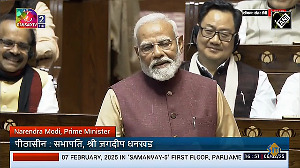The last wicket pair of Fidel Edwards and Corey Collymore battled grimly for the last 19 deliveries to earn the West Indies a thrilling draw in the first Test against India at St. John's, Antigua, on Tuesday.
Edwards and Collymore scored just a run each off 36 and eight deliveries they respectively faced, as the home side, chasing a daunting target of 392, finished on 298-9 off 95 overs in their second innings.
Earlier in the morning, medium pacer S Sreesanth had given India the whiff of victory when he struck twice in the morning and claimed the wickets of Ramnaresh Sarwan and Brian Lara, after leg spinner Anil Kumble had snared Darren Ganga, to have the West Indies reeling at 72 for 3 at lunch in their second innings. But Chris Gayle and Shivnaraine Chanderpaul put their heads down to deny India success in the postlunch session and take the West Indies to 158 without further damage at tea.
For his fine 212 Wasim Jaffer was adjudged man of the match.
Morning session
It's amazing what a change in mindset will do to on field performance.
In the first innings, Chris Gayle - as he said in post match interviews - shrugged off that close LBW shout when he was just three, freed arms and mind and went for broke, not really worrying about the chances of dismissal, unconcerned over mishits that flew under, over or wide of fielders. His job as he saw it was to start swinging and keep swinging.
Here, with the West Indies on the back foot and needing to save the Test, he did not have that luxury - and the difference was chalk to the Camembert of the first innings. Both seamers kept him tied down around that off stump, and when Munaf Patel (8-1-17-0) and Sreesanth (7-4-16-0) ended their first spells, the hard hitting southpaw had played out 16 deliveries from Patel for just two runs (24 off 30 in the first innings), and 30 deliveries off Sreesanth for just 7 (29 off 27 in the first innings).
He was clearly playing contrary to character - and it showed in his struggles to put bat to ball. Against that, Darren Ganga was playing his normal game - tight, compact, patient, and tuned to cashing in only when the bowlers erred. The orthodox, here, outscored the unorthodox two to one through the better part of the session - and in the way the two approached their job, indicated that the Windies game plan was clearly to get out of trouble, first, before even contemplating a frenetic late charge if and when the situation seemed conducive.
The first time Gayle attempted anything more in line with his normal character was when VRV Singh banged down one short ball too many; exasperated seemingly by the 11 successive dot balls he had just played out against Singh and Kumble before an edged single off the latter, he unleashed muscle power and without moving anything other than his arms, clubbed the ball flat, and hard, over the midwicket boundary and into the stands. One ball later, Ganga took over and played the more orthodox, and very eye-pleasing, cover drive off the bowler to find the fence.
Singh recovered well, bowling full on the stumps to Gayle to keep him tied down, following that up with a maiden to the same batsman in the next over. Curiously, though, the tall, strapping, seemingly fit youngster on debut was panting like an asthmatic on the walk back to the mark, in that 5th over - makes you wonder.
In between those two Singh overs, Anil Kumble - India's sole key, really, to cracking this game open -- got into the act. He had a long bowl during the session, during which he got bounce, and some turn. He had Gayle in all sorts of problems; in the 26th over, he started with a close shout against Ganga, nailing him in front only for Taufel to reckon otherwise. Off the last ball of that over, he bowled fuller, angled it to leg and turned it back to middle and off. Ganga pushed in defense with hard hands, and Yuvraj Singh, at short square leg, stretched reflexively to his left to pull off a good close in catch (36/78; Windies 67/1).
At the other end, Sreesanth was switched back in for Singh. The second ball of the over was fuller, and a touch wider of off, inducing the batsman to go for the drive. A hint of movement away made the difference - the ball flared off the edge of the bat, for a comfortable catch at point (1/7 Sarwan; Windies 68/2).
In the 30th over, Kumble went around the wicket, Gayle took a swing with arms and legs flailing, the ball climbed off pad onto bat onto glove and Dhoni held - and Simon Taufel ruled for the batsman (Gayle at the point 24/93; Windies 68/2); history repeating itself, with Gayle as in the first innings being given a second time at bat.
Interestingly, the commentators at the time looked at the replay and suggested that Taufel did not have the benefit of such technology, which on the first replay itself clearly indicated the man was out.
So why then do umpires say they don't want technology? What if, thanks to this much hyped "human element", Gayle goes on to win the game for his side?
Sreesanth, in the very next over, struck the blow that mattered. Lara is typically vulnerable early in his innings especially to the fuller length ball. The bowler got it in the right channel, swinging it in marginally from off to middle; Lara defended down the wrong line, and was nailed plump in front of middle - Asad Rauf paused long, agonizing moments before giving the verdict, and signaling lunch with 30.3 overs gone overall, 25.3 overs today, and the Windies on 72/3, having lost three big wickets for 59 runs during the morning session.
The young right arm seamer looked up at the skies in gratitude - and good for him. He was the villain of the piece in the first innings; commentators at the time queried the wisdom of giving him the new ball in the second innings, but he's got his mind back together here, and that should help his own development.
One final thought - had Gayle been given out as he clearly was, Windies at this point would be behind the eight ball, fair and square.
Post-Lunch session
The game nearly got nailed to the barn door immediately after lunch - Sreesanth, who had to bowl three deliveries of his unfinished over to open proceedings, in his first full over after the break got Chanderpaul, who at that point was yet to score, pushing away at an away-swinger that landed in the corridor to get the batsman into the shot, and left him late.
The thick edge flew to third slip, where Jaffar reacted a lifetime too late; the ball raced past his grasping hand to the third man fence for four.
Following the let off, Chanderpaul unveiled the Dr Jekyll side of his always schizophrenic batting make up. The man who had been content to stodge in the first innings while his mates went hot and heavy at the ball opened out, in a superlative sequence of flowing drives either side of the wicket.
He signaled intent with a lovely forward stride to shorten Kumble's length, and cream him through cover. At the other end, he took to Sreesanth, again the full stride forward shortening length and permitting immaculate control on the square drive; to the next ball, he repeated the shot, going down on his knee and holding the pose long enough to make sure the snapshot was taken.
With both Gayle (who got to his 50 off 142 deliveries during this session) and Chanderpaul playing with heads well down, India rotated its bowlers, stuck to lines and lengths and played the patience game that has been the prescription on this pitch ever since the initial life wore off on day three.
Virender Sehwag got a brief go at the two left handers in the 46th over, the 41st of the day, but though tight and controlled, the turn the part time off spinner got was too slow and too easily controlled to merit a more extended spell.
On this wicket, where two wickets had fallen in the course of two sessions, none in the first session of day four, and just four in the final two sessions, it was always going to be a question of patience. Batsmen prepared to put their heads down and grind it out were unlikely to be shifted - as Wasim Jaffar for instance demonstrated over the space of 503 minutes and 399 deliveries.
Gayle's patience endured - in the final over before tea, he badly misjudged a Kumble delivery and nearly let it on to his stumps, but when the leggie tossed one up, took the challenge and smashed him out of the stadium, to bring up tea on 158/3.
Both batsmen took a leaf out of the page, focusing on crease occupation and waiting, with bottomless patience, for the right ball to hit. The game, clearly, began to drift towards the draw that seemed the most likely option at the start of day five - at the break, though, India can ponder the `what ifs', such as `what if Gayle had been given out caught, when he was; what if Jaffar hadn't allowed the somnolence of lunch to dim his reflexes, but had gotten Chanderpaul out at the start of the session, putting pressure on Dwayne Bravo and the rest?
Hypotheticals, though, all of them - with 38 overs to go in the final session, a win by either side is clearly in the realm of miracles.
Post-Tea session
The understandably somnolent pace of play took an uptick three overs into the final session.
In the 60th over, Chris Gayle reached well forward with that long front foot of his, to take Kumble on the half volley from around the wicket and smash him over the covers for four. Predictably, the bowler went fuller and quicker; Gayle responded by shortening his stride a fraction to get behind and under the ball, and elevated it over the bowler's head, and the sightscreen backing him, for a huge six.
Kumble adjusted; he went around the wicket and angled one in on off and middle. Gayle stuck his front foot out, tucked his bat nicely behind, and paid for the misjudgment by being nailed in front (69/188; 171/4)
The last ball of the same over saw Kumble get some bounce; Dwayne Bravo, looking to force square, got the top edge for the ball to flash dangerously close to slip. And off the first ball of the next over, Chanderpaul looked to whip Munaf Patel off his pads, got the leading edge, and was lucky to see the ball drop just short of cover.
It was inexplicable, really - surely from the run of play thus far, Windies should have sussed out that playing head down, cutting out the fancy stuff was the only game in town for them?
The Indians during the session went flat out in attack, leading to interesting changes in strategy. Anil Kumble for instance went round the wicket to the right handed Bravo with a slip, silly point, short square and short fine leg, the last in an almost withdrawn leg slip position. And Sehwag bowled with slip, silly point, leg slip, short square.
With the Indians ringing both batsmen, Kumble stayed round the wicket to the left hander as well. To a delivery around outside off in the corridor, Chanderpaul pushed at it, got the pad, then the outer edge of the bat and Dravid dived at slip to hold.
The batsman again walked off muttering and shaking his head, as he had in the first innings - unfortunately for him, he was as out here, as he was then. It was a fluid, easy knock; unlike in the first innings where he dug in deep, Chanderpaul here refused to allow either the situation or the bowlers to dictate the nature of his play (202/5; 62/109 - and 27.3 overs to go).
Five overs later, Sehwag struck. The off spinner got one to drift late, from line of off to just outside, on the very full length. Bravo, who in the previous over had clubbed Kumble for successive fours, was drawn into the defensive push; the drift found the edge and Dhoni did very well to hang on to the reflexive catch (28/41; 23 overs still to go).
An over later, Sehwag struck again. This time, it was the regulation off break, bowled a touch wide of off turning in. Ramdhin played the width and shaped to cut; the ball curving back in cramped him for room and Dravid, initially unsighted by the keeper, did well to keep his nerve and hold after an initial juggle (8/21; 226/7).
With the Indians now posting six, at times seven around the bat and both spinners willing to buy wickets if that was what it took, Dave Mohammad played some fancy shots, hitting through the line on both sides of the deck to repeatedly find the fence while at the other end, Bradshaw did what the situation demanded, and dug in deep.
The new ball was taken on schedule, at the end of 80 overs to a field of four slips and a gully; Mohammad continued his edgy play, and lofted the second ball of the 81st over, from Munaf Patel, over mid off for four; then hit air twice on the trot as Munaf changed the angle, going around the wicket; on both occasions, the ball missed the stumps by the proverbial whisker.
Bradshaw's grim resistance ended when Munaf landed one closer to off on the angle across the left hander. The batsman had to play at it; the movement got the feather - or not; replays remained inconclusive, though the suspicion is he didn't touch it -- through to the keeper and the batsman inched off the ground, almost walking in reverse, while the crowd booed the decision, then began to say it with bottles (10/32; 277/8; 10.4 overs to go).
A rather unfortunate moment, that - apparently it is okay enough when Gayle gets first bat, then glove, onto the ball and is reprieved and goes on to play out another 95 deliveries, and add a further 45 runs, but not if the decision goes the other way - an unfortunate, but all too globally pervasive, aspect of international cricket in this modern era; the crowd at the ARG no more culpable than a fair few others.
Mohammad's counter-attacking innings deserves high praise; his shots had nothing of the tail-ender's slap happy style to them but were out of the top draw, with drives on either side of the wicket dominating the stirring effort - three fours marked the 87th over as the batsman took to Munaf Patel, taking full advantage of a field that by then was totally unconcerned about runs going.
What was praiseworthy about it was that despite it being a situation calling for defense, Mohammad played the percentages, defending where he needed to but not getting bogged down, the precursor to being taken out.
At the other end Fidel Edwards, who was pressed into game-saving service complete with dodgy hamstring and runner, hung on grimly against an Anil Kumble attempting to break the land speed record with his flippers.
The second ball of the 90th over should have hammered another nail in the coffin. Mohammad moved forward into a drive, was beaten by Kumble's drift and turn outside off, but Dhoni's grasp ended with the ball bouncing off, in the process letting the simple stumping chance go by, with 5.4 overs still to go.
Kumble promptly went around the wicket, Mohammad pushed at it, and the edge flew just past the diving Dravid at slip - another potential chance and the resulting runs took Mohammad to a deserved 52 off 50 deliveries.
With just 3.2 overs to go, Mohammad's vigil ended. Kumble, who kept switching between over and around to change angles of attack, floated one right up at the batsman. Mohammad, who all along had been driving at such deliveries, moved into the shot but this time, the ball was too full. His bat swing went all around the delivery, and the ball nipped back just enough to hit leg stump (52/55; 297/9 with 3.1 overs left).
With four slips, two gullies, a silly point and a short square around him, Edwards hung on grimly to the 93rd over, bowled by Sreesanth.
The penultimate over pitted Kumble against Corey Colleymore - but tension told, the bowler overpitched, and the tailender got away from the danger end with a first ball single, to the sort of cheers that normally accompany a Lara double century. Edwards kept head, bat, pad, everything down - and kept Kumble out.
The final over - Sreesanth to Colleymore: a defensive push first up; a good short one narrowly evaded to the second; ball three on the stumps and full and Colleymore puts bat in the way; a pause for prolonged midwicket conversation, and two more grim defensive prods; Sreesanth struck pad with the final ball to have the entire Indian team up in appeal, but that one was turned down, and the Windies scrambled a draw where, with 130 by way of lead at the end of the halfway stage, they had looked to win.
For India, a case of so near, yet so far - the positive they can and likely will take away is that the "pussycats abroad" had after a rocky start made most of the running over the final three days, and ensured they wouldn't get into the business end of the series with heads down.
An interesting point that has cropped up repeatedly in email exchanges with friends is the possibility that India could have looked to have pushed on a bit quicker, and gotten a few more overs at the West Indies batsmen. 450 runs ahead in 20 overs less was more or less the consensus suggestion - that is to say, India should have been around 580 runs in around 130 overs.
The good bit about hindsight is it is always 20/20. But then what? A target for the West Indies of 4 an over, with 110 overs to get there? On the ground where, in May 2003, the West Indies successfully got 418 for seven in 128.5 overs to win a Test - against the world champion side boasting an attack that read Glenn McGrath, Jason Gillespie, Brett Lee, Stuart McGill and Andy Bichel?
To set that target, India would have had to make 580 runs in 130 overs, India would have had - coming into the second innings 130 runs behind, with the consequent risk that losing wickets in the push for quick runs would toss the game, gift-wrapped, into the opposition's lap - to have scored at 4.46 per over throughout its innings.
Assume that was possible for the Indians, then by what logic is a run rate of 4 not possible, on the same pitch, for the opposition?
A team that after being 130 behind in the first innings lost the game setting that sort of gettable target on a pitch that has played placid throughout would have been incarcerated in an asylum for the criminally insane - quite rightly too, IMHO.
But then, this is Indian cricket - as I mentioned in a report yesterday, the game is played by different rules: When India bats, it needs to get fours and sixes at the rate of at least four every over; when the opposition bats, the boundaries have to dry up and wickets have to tumble. Trick is to get the other teams to buy into that.
Jeremy Coney made an interesting aside: The 15 minutes, potentially five overs, that were lost yesterday while the umpires dithered could as easily have had an impact on the outcome. But that, and all else, is strictly the stuff for bar room conversation.







 © 2025
© 2025